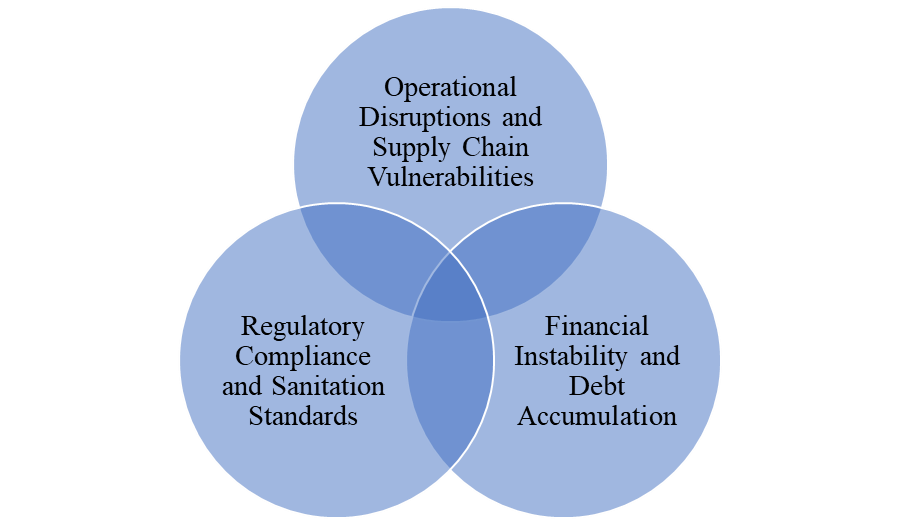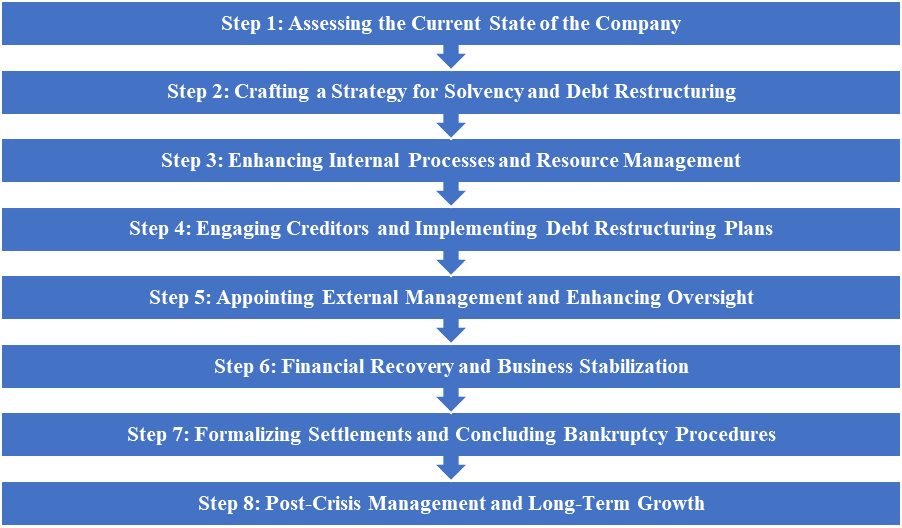- Introduction
The food industry plays a vital role in public health and economic stability. Unlike other sectors, food enterprises face unique operational, regulatory, and logistical constraints. The perishable nature of products, stringent safety regulations, and global supply chain dependencies increase the vulnerability of food enterprises during crises. The COVID-19 pandemic revealed the extent of this vulnerability, as disruptions to transportation, production, and labor availability caused severe shortages of essential food products [1]. Research highlights that supply chain disruptions during this period led to a 25% increase in operational costs and delayed production timelines for critical goods like fresh produce and dairy products [2].
- Materials and methods
Instances of Operational Disruptions and Supply Chain Vulnerabilities, Financial Instability and Debt Accumulation, and Regulatory Compliance and Sanitation Standards exacerbate these challenges.
Structure of food enterprises’ constraints are depicted below (Fig. 1).

Figure 1. Structure of food enterprises’ constraints
- Operational Disruptions and Supply Chain Vulnerabilities: Operational disruptions, particularly those affecting supply chains, are among the most severe challenges faced by food enterprises. Delays in supply chain deliveries impact production schedules and lead to increased operational costs. Reliance on just-in-time production models limits flexibility in managing inventory shortages. Case study: The COVID-19 pandemic disrupted global food supply chains, affecting raw material availability and transportation logistics (WHO, 2023).
- Financial Instability and Debt Accumulation: Financial instability can lead to bankruptcy, insolvency, and asset liquidation. Debt accumulation hinders the enterprise’s ability to finance production activities. Research findings by Green (2023) identify debt accumulation as a major driver of business failure in the food industry.
- Regulatory Compliance and Sanitation Standards: Food enterprises operate under strict regulatory oversight aimed at protecting public health. Failure to meet hygiene standards results in fines, production halts, and loss of consumer trust. Compliance with ISO 22000 and FDA food safety regulations is essential for maintaining operations during a crisis (ISO, 2023).
Food enterprises were forced to rely on emergency loans and debt restructuring to maintain liquidity during the COVID-19 crisis, with many companies experiencing a surge in debt obligations by up to 40% [3]. For example, businesses that failed to restructure their financial obligations were at a higher risk of insolvency, as noted in case studies of mid-sized enterprises in the European food sector [4].
Compliance with regulatory standards adds another layer of complexity. Enterprises must adhere to standards set by regulatory bodies like the ISO and FDA. Failure to meet these standards results in fines, production halts, and the loss of consumer trust. During the COVID-19 crisis, regulatory bodies like the FDA issued new health and safety guidelines that required companies to invest in personal protective equipment (PPE) and sanitation protocols, increasing operational costs by 15% [5]. Companies that implemented comprehensive sanitation measures, such as continuous hygiene checks and periodic facility audits, were better able to continue production without disruptions [6].
- Financial Recovery and Debt Restructuring: Engage with creditors to negotiate revised payment terms, such as lower interest rates and extended repayment schedules. Develop cash flow forecasts and liquidity plans to stabilize cash availability for operations. Example: Harris (2023) highlights how negotiating with creditors and lenders improved financial stability for distressed food enterprises.
- Operational Optimization and Workforce Retention: Optimize production workflows and reduce cycle times through Lean or Six Sigma methodologies. Implement employee retention programs, including financial incentives and flexible work arrangements. Example: Brown (2023) underscores the importance of predictive maintenance and employee incentives to maintain production stability.
- Regulatory Compliance and Sanitation Adherence: Ensure adherence to health and safety regulations by enhancing hygiene protocols and conducting regular audits. Identify and mitigate risks related to food safety, employee health, and environmental impact. WHO (2023) and ISO (2023) recommend continuous employee training and system audits to meet food safety requirements.
- Supply Chain Resilience and Diversification: Reduce reliance on single suppliers and establish alternative sourcing arrangements. Use supply chain tracking tools for enhanced visibility and decision-making. Deloitte Insights (2024) reveals how companies diversified supply chains to increase resilience amid COVID-19-related disruptions.
Addressing these vulnerabilities requires a structured, integrated approach to crisis management, which focuses on operational stability, financial restructuring, and compliance with regulatory standards. Case studies from global food enterprises demonstrate the effectiveness of this approach. For instance, firms that implemented early debt restructuring efforts, like renegotiating payment schedules and securing lower interest rates, were able to reduce their financial risk exposure by 20% [7]. Operationally, companies that diversified their supplier base and adopted digital supply chain tracking tools reported shorter recovery times during the pandemic [8].
Global supply chain dependencies further complicate the issue. When major shipping hubs faced lockdowns, food exporters experienced bottlenecks in international trade, as witnessed in delays at the Port of Los Angeles and Rotterdam [9]. The reliance on a limited number of key suppliers increased the impact of these disruptions, leading to severe product shortages. Companies like Walmart and Tesco responded by diversifying suppliers and implementing predictive analytics to forecast delays and take pre-emptive action [10].
As highlighted by research, companies that integrated operational flexibility with financial restructuring and compliance efforts achieved better crisis outcomes. Companies that optimized supply chain processes through automation and machine learning tools saw improved forecasting accuracy and reduced wastage [11]. Financial restructuring strategies, such as converting short-term debt into long-term obligations, provided firms with the liquidity needed to weather prolonged crises [12]. Regulatory compliance was achieved by aligning with ISO 22000 and conducting frequent internal audits, ensuring smooth operations and minimizing production stoppages [13].
The introduction of best practices from crisis management research shows that holistic approaches that encompass operational stability, financial health, and regulatory compliance significantly enhance the ability of food enterprises to navigate disruptions. For instance, companies that engaged in early risk assessments and diversified their supplier network were able to mitigate shortages and sustain operations, as seen in the example of the Brazilian meat export sector during the pandemic [14]. Research underscores the importance of comprehensive frameworks, as illustrated by case studies from MNP (2024) and the Strategic CFO (2024), which emphasize the role of predictive modeling and proactive financial planning [15].
The crisis management methodology includes a step-by-step approach that encompasses all aspects of crisis management — from analyzing the financial and legal position of the company to implementing operational measures and concluding settlement agreements with creditors. The main stages of the methodology include [2]:
- Analysis of the company’s current state, including financial and legal audits.
- Development of a strategy for restoring solvency, restructuring debt obligations, and optimizing expenses.
- Optimization of internal processes and resources, retention of key employees, and maintenance of sanitation standards [4].
- Interaction with creditors, development of a legally justified debt restructuring plan, and conclusion of a settlement agreement [2].
- Post-crisis management and strategic planning for the company’s sustainable development.
The application of the proposed methodology enabled food industry enterprises to achieve significant improvement in key performance indicators [2]. As a result, the following changes were recorded:
- An increase in revenue by 20% after debt restructuring.
- Reduction of operating costs by 25% due to the optimization of production processes [3].
- Reduction of debt burden from 50% to 35%, which reduced the risk of bankruptcy [6].
- An increase in operating margin from 15% to 18%, which strengthened the financial stability of the enterprise [2].
- Results and Discussion.
The study results demonstrate that the integration of financial, operational, and regulatory measures reduces risks for food industry enterprises. The application of Lean methods and process automation allows companies to reduce costs and increase productivity [3]. In addition, optimizing debt management through debt restructuring not only avoids bankruptcy but also improves relationships with creditors [2]. Effective crisis management helps companies maintain operational stability and regain lost market positions [5].
A new improved methodology of all aspects of crisis management depicted below (Fig. 2) is created for improved efficiency food enterprises in crisis.

Figure 2. New improved methodology of all aspects of crisis management.
Crisis management in the food industry requires a comprehensive approach aimed at improving financial stability, optimizing internal processes, and protecting the interests of creditors. The implementation of the developed methodology allows companies not only to overcome the crisis but also to create a foundation for the company’s long-term sustainability [6]. The proposed approach takes into account the specifics of the food industry, including the need to maintain product quality and comply with sanitation standards. Implementing this methodology helps strengthen the company, increase its competitiveness, and ensure long-term market stability [3].
References
1. Impact of COVID-19 on the food supply chain. Food Quality and Safety, Volume 4, Issue 4, December 2020, Pages 167–180.Available at: https://academic.oup.com/fqs/article/4/4/167/5896496
2. The Evolution of Debt Restructuring: Strategies for Companies Facing New Economic Realities by Doug Robertson Available at: https://mastheadfca.com/the-evolution-of-debt-restructuring-strategies-for-companies-facing-new-economic-realities/
3. Food Supply Chain Shocks and the Pivot Toward Local: Lessons From the Global Pandemic by E Melanie DuPuis, Elizabeth Ransom, Michelle R. Worosz. Available at: https://www.frontiersin.org/articles/10.3389/fsufs.2022.836574/full
4. COVID-19 has broken the global food supply chain. So now what? Available at: https://www.deloitte.com/ch/en/Industries/consumer/perspectives/covid19-has-broken-the-global-food-supply-chain.html
5. World Health Organization (2023). Food Safety and Supply Chain Disruptions: Key Insights from the COVID-19 Pandemic.
Available at: https://www.who.int/news/item/13-10-2023-food-safety-and-supply-chain-disruptions-key-insights-from-the-covid-19-pandemic
6. Corporate restructurings are on the rise - but why? Available at: https://the-cfo.io/2024/07/09/corporate-restructurings-are-on-the-rise-but-why/
7. ISO 22000:2018. Food safety management systems — Requirements for any organization in the food chain Available at: https://www.iso.org/standard/65464.html
8. OECD (2023). Food Supply Chains and COVID-19: Impacts and Policy Lessons. Available at: https://www.oecd.org/coronavirus/policy-responses/food-supply-chains-and-covid-19-impacts-and-policy-lessons-71b57aea/
9. MNP (2024). Navigating Financial Uncertainty: Restructuring Solutions for Food and Beverage Processors. Available at: https://www.mnp.ca/en/insights/directory/restructuring-solutions-for-food-and-beverage-processors
10. EY (2023). How COVID-19 Impacted Supply Chains and What Comes Next.
Available at: https://www.ey.com/en_us/insights/supply-chain/how-covid-19-impacted-supply-chains-and-what-comes-next
11. FTC (2024). FTC Releases Report on Grocery Supply Chain Disruptions.
Available at: https://www.ftc.gov/news-events/news/press-releases/2024/03/ftc-releases-report-grocery-supply-chain-disruptions
12. Capstone Partners (2024). Food Sector Mergers & Acquisitions Update – October 2024.
Available at: https://www.capstonepartners.com/insights/article-food-sector-mergers-acquisitions-update/
13. World Bank Group (2020). Publication: Overview of Insolvency and Debt Restructuring Reforms in Response to the COVID-19 Pandemic and Past Financial Crises: Lessons for Emerging Markets
Available at: https://openknowledge.worldbank.org/handle/10986/35425
14. Accounting Insights (2024). Debt Restructuring: Strategies for Corporates and Individuals. Available at: https://accountinginsights.org/debt-restructuring-strategies-for-corporates-and-individuals/
15. Strategic CFO (2024). What Is Debt Renegotiation and How It Can Lead to Business Survival. Available at: https://strategiccfo.com/articles/restructuring-services/what-is-debt-renegotiation-and-how-it-can-lead-to-business-survival/
